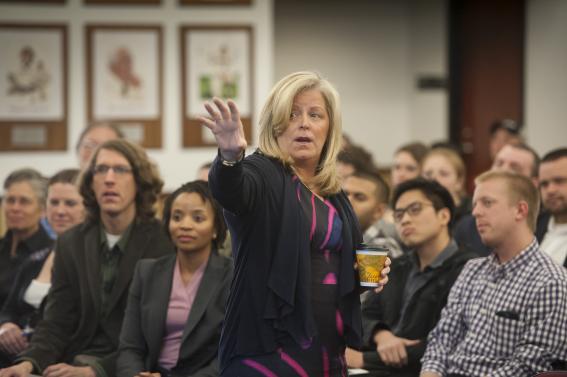Executive-in-Residence Stacey Allaster Highlights WTA’s Challenges and Her Life in Tennis
April 15, 2015

During her residency, Allaster gave class presentations and met with students, faculty, and members of the UMass varsity tennis team. She also delivered a keynote address to the campus community and participated in the McCormack Sport Innovation Oral History in cooperation with the University Archives at the UMass Amherst Libraries.
An Expanding Global Footprint
Allaster’s address and an interview emphasized the WTA’s expansion of its global footprint, notably in East and South East Asia. WTA tournaments now comprise 55 events in 33 countries. Five major events, she added, contribute almost half of the tour’s prize money. The WTA represents 173 full-time members. Its players hail from 92 nations.
With 27% of the world’s Gross Economic Product, East and South East Asia, she said, offer unprecedented opportunities for the WTA. Inspired by former NBA commissioner David Stern’s initiatives in China, the WTA now offers ten tournaments in Mainland China and additional events in Hong Kong, Taipei, and Singapore.
The WTA and Singapore have teamed up in a multi-year partnership to host the association’s annual finale for its 43-week tour. Even by Asia’s supersized standards, it’s a larger-than-life affair, including seven days of competition and a free ten-day Fan Fest with access to the players as they practice, celebrations, and concerts. “For the first year [in November of 2014], we promised revenues of $100 million and delivered $182 million,” she remarked.
Growing a Fan-Focused Culture
The WTA ultimately serves its owners—the players and the tournaments—who share 50/50 in the organization’s income. But those interests, Allaster underscored, are best served by focusing on the fans. “Take care of your customers; that will grow your business,” she told her UMass audience.
That focus, she continued, represents a cultural shift for the WTA, which had previously been more inward facing. To that end, the WTA has embraced data-driven planning and feedback, rapid market expansion, and new technologies. Allaster, then, is driving a more proactive, data-driven business culture. That impacts branding, where the association is doing more to control its narrative: “We were reacting and letting everyone else tell our story. Yet we have the behind-the-scenes access [to our players] that nobody else has,” she mused.
Technology, Tennis, Entertainment
To improve the fan experience, Allaster recruited marketing and data analysis professionals, who have surveyed WTA and general sports fans. The research revealed that the fans’ top priority is to follow players from their own countries—their national heroes. Because those heroes compete on the fly in 33 countries, they’ve been hard to follow—“out-of-sight/out-of-mind,” she said. That will change in 2017, with a state-of-the-art WTA app that will allow fans to view live any WTA singles match on the planet.
Technology will bring other improvements. Cloud-based feeds that convey instant results, clips, sabermetric-type analysis, and news about tennis personalities and lifestyles will complement the live viewing experience. (Glamor remains a significant component of women’s tennis, noted Allaster.) Robotic cameras and wearable sensors will make that experience up-close-and-personal. “Imagine Serena wearing a tiny camera on her visor,” remarked Allaster. “How cool would that be?”
Allaster and the WTA are striving for a more robust fan experience that includes exposure to the “pre- and post-match habitats,” like practice sessions and player contact with fans, both in person and via social media. And as the finals in Singapore have demonstrated, tennis events can dovetail strategically with other forms of entertainment like celebrations and concerts. We should view tennis, said Allaster, not as a “sports industry” but as a “sports entertainment industry.”
For the tournaments and especially the players, the Return on Investment from Allaster’s initiatives speaks for itself. The trajectory of revenues, she emphasized, is growing exponentially. “It took us 40 years to reach $100 million,” she observed. “That was in 2013. By 2020 we expect revenues to reach $178 million.”

Allaster credited her fierce advocacy for women’s tennis to her gratitude to the sport tennis and to her passion for the advancement of women. “Tennis has given me everything, beginning at age twelve when I was chosen by a local tennis association [in her native Welland, Ontario] to receive a racquet, membership, and lessons. As a teenage daughter of a working-class single mother, she cleaned the club’s courts and found a mentor.
After graduating from the University of Western Ontario with bachelor’s degrees in athletics and economics and an MBA, Allaster became director of player development and a tennis pro with the Ontario Tennis Association. Her career took off in 1991 with Tennis Canada, where for 14 years, she tackled increasing challenges as vice president of sales and marketing. She became president of the WTA in 2006 and has been its chairman and CEO since 2009.
It has been nothing less than an honor to give back to tennis,” Allaster emphasized. “I am incredibly competitive and driven. But ultimately there’s a greater story than forehands and backhands. It’s the empowerment of girls and women.”